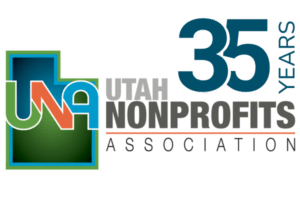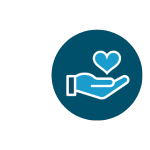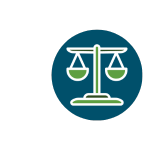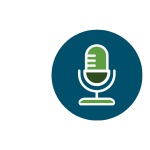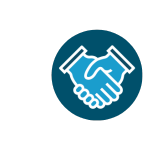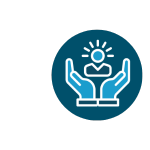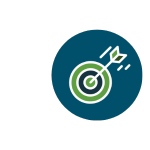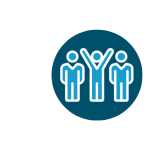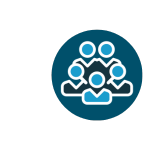Grow Smarter, Dream Bigger: Build Capacity for the Future
You work hard to make a difference to build a better future. What if you could give your organization the structure it needs to thrive, no matter what challenges come your way? That’s exactly what the Nonprofit Credential delivers—transformative training designed with your success in mind.
This nine-course series is more than just education; it’s a game-changing experience for your nonprofit that builds your knowledge, trains your team, and supports your big dreams. Here’s how it works:
Your Journey to Excellence Includes:
- Two Days of Hands-On Training: Dive into practical knowledge and skills that directly impact your nonprofit’s success.
- Tailored Post-Training Guidance: Work one-on-one with a subject matter expert to solve the problems that are unique to your organization.
- Ongoing Support: Receive personalized coaching to ensure best practices become second nature at your organization.
- Credential Badge: Showcase your achievement and your commitment to excellence—because your hard work deserves recognition.
When your organization completes the course requirements and implements these strategies, you'll earn the official Nonprofit Credential Badge—proving to the world that you’re leading with excellence.
Take the first step toward building a stronger, more resilient nonprofit.
Explore our 2025 course offerings on our Training and Events Calendar.
Can’t make the live sessions? No worries—while it's more beneficial to attend the live courses, we record the sessions so you can watch them on your schedule.
The UNA Credential is intended and designed for nonprofit organizations, inviting leadership and key personnel to actively engage in organizational development. Individuals and for-profit businesses are better suited for UNA's regular suite of Trainings and Events.
Program Components
Interactive Training
Master new skills in essential areas like Fundraising and Development, Finance and Legal, Advocacy and Civic Engagement, and more!
Expert Consultation
Take advantage of individualized consultation as you implement policies and practices at your own organization.
Ongoing Coaching
Sign up for continued coaching sessions to help you refine your approach and strengthen your organizational strategies.
Badge Earning
Complete all course requirements and earn a Credential Badge to publicly acknowledge your achievement and demonstrate your commitment to organizational excellence.
What You Need to Know
Build Your Capacity in Nine Essential Areas
Unlike traditional professional training programs, the Nonprofit Credential prioritizes your organization's needs while respecting its unique culture and capacity. Built on a foundation of high-quality education, the Nonprofit Credential empowers you to directly implement course materials within your organization. By strengthening your organizational capacity, you'll build a more resilient nonprofit that can adapt seamlessly to external and internal changes.

Earning a Credential Badge means more than personal growth—it's about increasing your nonprofit's impact and demonstrating your commitment to excellence. Depending on the course, you’ll see more effective fundraising, reduced risk from improved financial oversight, better data collection and reporting, more effective messaging, and improved HR policies to protect your organization and staff team.
We'll support your accomplishment by giving you a press and promotional kit, highlighting your organization's achievement in our communications, and providing you with a letter to share with stakeholders that outlines your success and why it matters.
Notable Achievements
 UNA's highest honor, the UNA Credential Award, is given to nonprofits that receive Nonprofit Credential Badges in all nine Credential courses.
UNA's highest honor, the UNA Credential Award, is given to nonprofits that receive Nonprofit Credential Badges in all nine Credential courses.
The Haven, 2018
Humane Society Moab Valley, 2021
Mountain West Mothers' Milk Bank, 2021
Friends of the Children - Utah, 2023
United Way of Northern Utah, 2023
The INN Between, 2023
Color Country Animal Welfare, 2024
ADVOCACY AND CIVIC ENGAGEMENT BADGE
2015
Utahns Against Hunger
Volunteers of America, Utah
2018
Boys & Girls Clubs of Weber-Davis
YMCA of Northern Utah
The Haven
International Academies of Emergency Dispatch
Moab Valley Multicultural Center
Association of Nature Center Administrators
2019
English Skills Learning Center
WabiSabi
Humane Society of Moab Valley
2020
Mountain West Mothers' Milk Bank
The INN Between
2021
Wonderbloom
Disabled Rights Action Committee
Friends of the Children
Downtown Ogden Alliance
Habitat for Humanity of Southwest Utah
2022
Get Healthy Utah
2023
Mundi Project
United Way of Northern Utah
Color Country Animal Welfare
BOARD GOVERNANCE BADGE
2016
Utah Afterschool Network
RiteCare of Utah
2017
Humane Society of Moab Valley
WABISABI Moab
2018
Allies with Families
Neighborhood Art Center
The Haven
Alta Community Engagement
2020
Mountain West Mothers' Milk Bank
English Skills Learning Center
2021
Flourish Bakery
Utah Down Syndrome Foundation
2022
Friends of the Children Utah
Mormon Women for Ethical Government
Get Healthy Utah
Onstage Ogden
2023
United Way of Northern Utah
The INN Between
Mundi Project
2024
Color Country Animal Welfare
Grandview for Good
Utah FFA Foundations
American Indian Services
FINANCE AND LEGAL BADGE
2015
Catholic Community Services
2018
The Haven
2020
Mountain West Mothers' Milk Bank
2021
Humane Society Moab Valley
Wonderbloom
Friends of the Children Utah
Peace House
Mundi Project
2023
The INN Between
Onstage Ogden
Cholangiocarcinoma Foundation
United Way of Northern Utah
Color Country Animal Welfare
2024
UCAIR (Utah Clean Air Partnership)
Fit to Recover
Youth Garden Project
The Christmas Box International
American Indian Services
FUNDRAISING AND DEVELOPMENT BADGE
2017
Maliheh Free Clinic
RiteCare of Utah
Stokes Nature Center
Volunteers of America, Utah
KRCL Listeners Community Radio
Friends of Great Salt Lake
United Way of Northern Utah
2018
Grand Area Mentoring
Humane Society of Moab Valley
Moab Music Festival
WabiSabi Moab
Bountiful Davis Art Center
The Haven
Utah Association for the Education of Young Children
Friends of Switchpoint Inc.
Safe Harbor Crisis Center
The Riley Foundation
2019
Utah Avalanche Center
Art Access
Latino Behavioral Health
Circles Salt Lake
Making a Difference Foundation
Neighborhood House
Peace House
World Peace Parents Foundation
Equality Utah
Pregnancy Resource Center of Salt Lake City
Midwives College of Utah
2020
Hope Philanthropies
The INN Between
Fit to Recover
2021
Your Community Connection Family Crisis Center
Mountain West Mothers' Milk Bank
Flourish
Canyonlands Field Institute
YCC Family Crisis Center
2022
Neighborhood House (recertified)
Friends of the Children Utah
Mundi Project
Loveland Living Planet Aquarium
2023
United Way of Northern Utah
Color Country Animal Welfare
Kimball Art Center
2024
English Skills Learning Center
Her Infinite Worth
Mormon Women for Ethical Government
Utah Food Allergy Network
Valley Behavioral Health
Onstage Ogden
American Indian Services
Canyon Creek Women's Crisis Center
2025
Association of Nature Center Administrators
Humane Society of Utah
Rape Recovery Center
Stellar Vista Observatory
The Motley Squad
Ogden Nature Center
HUMAN RESOURCES BADGE
2016
Junior Achievement of Utah
Utah Afterschool Network
2017
Holding Out HELP
Friends of Alta
2018
The Haven
2019
Maliheh Free Clinic
Tracy Aviary
The INN Between
2020
Humane Society of Moab Valley
Mountain West Mothers' Milk Bank
Fathers and Families Coalition Of Utah
2021
YCC Family Crisis Center
Friends of the Children Utah
Safe Harbor Crisis Center
Mundi Project
2022
Suazo Business Center
Ogden Downtown Alliance
Canyon Creek Services
Christian Center Park City
HEAL Utah
Cholangiocarcinoma Foundation
2023
Utah Legal Services
Women of the World
United Way of Northern Utah
Color Country Animal Welfare
Neighborhood House
2024
American Indian Services
Association of Nature Center Administrators
Episcopal Community Services
Fit to Recover
Peace House
The Christmas Box International
Wasatch Community Gardens
LEADERSHIP AND ORGANIZATIONAL CULTURE BADGE
2015
English Skills Learning Center
Playworks Utah
2016
RiteCare Utah
Humane Society of Moab Valley
Safe Harbor Crisis Center
DOVE Center
2017
YMCA of Northern Utah
Utah Nonprofits Association
2018
The Haven
Alta Community Enrichment
2020
Mountain West Mothers' Milk Bank
2021
The INN Between
Friends of the Children - Utah
2022
Recycle Utah
United Way of Northern Utah
2024
Wasatch Community Gardens
Equality Utah
The Motley Squad
Color Country Animal Welfare
MARKETING AND COMMUNICATION BADGE
2015
Utah Food Bank
Holy Cross Ministries
2016
I.J. & Jeanné Wagner Jewish Community Center
Friends for Sight
English Skills Learning Center
Youthlinc
2017
Pregnancy and Resource Center
Discovery Gateway
Community Development Corporation of Utah
Golden Rule Project
Suazo Center
2018
The Phyllis and Mark Leppert Foundation for Fertility Research
Volunteers of America Utah
The Haven
Park City Film Series
Utah Community Action
The INN Between
Utah Parent Center
Communidades Unidades
2020
Root 4 Kids
St. George Children's Museum
Heart Walk Foundation
Habitat for Humanity of Southwest Utah
Ogden Downtown Alliance
Mountain West Mothers' Milk Bank
Humane Society of Moab Valley
Catholic Community Center
Wasatch Adaptive Sports
House of Hope
Big Brothers and Big Sisters of Utah
2021
Granite Education Foundation
Neighborhood House
Wonderbloom
Heart & Soul
Urban Food Connections of Utah
Utah Down Syndrome Foundation
Canyonlands Field Institute
Community Action Services and Food Bank
2022
Get Healthy Utah
Jewish Family Service
Friends of Cedar Mesa
The Salt Lake City Public Library
Bicycle Collective
Friends of the Children Utah
Guadalupe School
UServeUtah
Utah Microloan Fund
Mormon Women for Ethical Government
2023
Spy Hop
Boys & Girls Clubs of Greater Salt Lake
Volunteers of America, Utah
Color Country Animal Welfare
Neighborhood House
Catholic Community Services
United Way of Northern Utah
Utah Domestic Violence Coalition
2024
Children's Service Society of Utah
Humane Society of Utah
Association of Nature Center Administrators
Rape Recovery Center
Utah Afterschool Network
2025
Canyon Creek Services
The Motley Squad
The Refuge Utah
Her Infinite Worth
Mountain Mediation Center LLC
Neighborhood House
Stellar Vista Observatory
UP for Learning
Utah Olympic Legacy Foundation
OUTCOMES AND EVALUATIONS BADGE
2015
English Skills Learning Center
2017
Summit Community Gardens
Utah Community Action
Craft Lake City
2018
The Haven
2019
Columbus Community Center
Granite Education Foundation
2020
Rite Care Utah
2021
Mothers Without Borders
Clark Planetarium
Salt Lake Education Foundation
Friends of the Children Utah
The INN Between
2023
Cherish Families
United Way of Northern Utah
Boys & Girls Clubs of Greater Salt Lake
2024
Color Country Animal Welfare
Canyonlands Field Institute
Project Apis m.
2025
The Motley Squad
Utah Symphony | Utah Opera
VOLUNTEER MANAGEMENT BADGE
2016
The Living Planet Aquarium
Utah Domestic Violence Coalition
Youthlinc
Humane Society of Moab Valley
2018
Utah Division of Wildlife Resources Lee Kay Public Shooting Range
Cottonwoods Canyon Foundation
United Way Salt Lake
Arrive Utah
Crossroads Urban Center
Big Brothers Big Sisters of Utah
Heritage Choir
The Haven
United Way Dixie
The Bicycle Collective
2019
Save Our Canyons
The INN Between
Dixie Serves
2020
Mountain West Mothers' Milk Bank
2021
Wild Utah Project
Alliance for a Better Utah
Utah Valley Refugees
Flourish
Safe Harbor Crisis Center
YWCA Utah
Green Urban Lunch Box
Disabled Rights Action Committee
Catholic Community Services
CAPSA
The Cholangiocarcinoma Foundation
Craft Lake City
2023
Friends of the Children
United Way of Northern Utah
Color Country Animal Welfare
Mormon Women for Ethical Government
Children's Service Society of Utah
First Step House
2024
Her Infinite Worth
Root for Kids
Youth Sports Alliance
Ogden-Weber Community Action Partnership
2025
Canyon Creek Services
The Motely Squad
Valley Behavioral Health
HUMAN RESOURCES AND VOLUNTEER BADGE*
2015
RiteCare of Utah
2016
Junior Achievement of Utah
Utah Afterschool Network
2017
Holding Out HELP
Friends of Alta
COMMUNITY IMPACT **
* Course split into two separate Credentials
** Course changed to Advocacy and Civic Engagement
Your Stories Matter—How Nonprofit Credentials Have Made a Difference
"As a first-time Executive Director at a very new non-profit, I often feel lost about what to do and where to start. The Utah Nonprofits Association's Credential program has been a life-saver!
The trainings are taught by experts currently working in the field which lends credibility and trust to the Credential. The presenters have a wealth of information to provide, which could be overwhelming, but they break it down into easy-to-implement steps that is well-organized. One of the most helpful parts has been the follow-up meetings where we can connect one-on-one with the experts to ask questions specific to our organization.
After such success with the two Credential programs I've done so far, I plan to complete ALL of them over the next couple of years. Our organization wouldn't normally be able to afford this kind of top-quality training, but UNA makes it affordable for our tight start-up budget. I hope UNA continues to have funding to provide this incredibly useful and essential program."
- Sarah Stone, PhD, Executive Director, Wonderbloom: Nature Playschool
UNA extends deep gratitude to Justin B. Anderson for his imagination and support in updating the UNA Badges.
